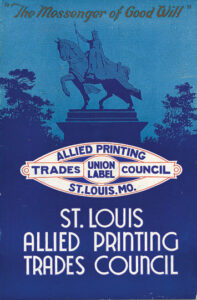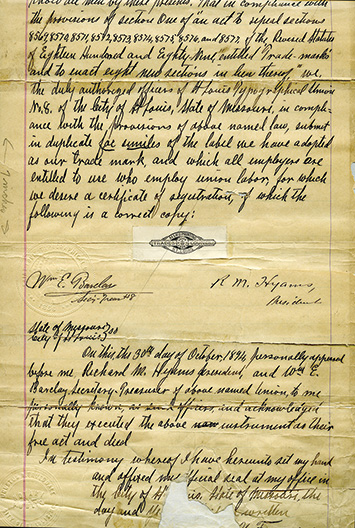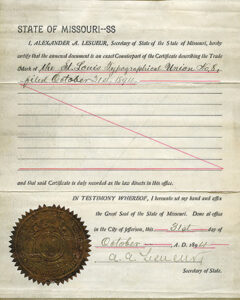
 The Allied Printing Trades Council Union Label was the most recognized union label for many decades. Founded and designed by the International Typographical Union (ITU), the oldest union in the United States before its dissolution in 1986, it was used on nearly every product printed and produced by unions in the printing industry.
The Allied Printing Trades Council Union Label was the most recognized union label for many decades. Founded and designed by the International Typographical Union (ITU), the oldest union in the United States before its dissolution in 1986, it was used on nearly every product printed and produced by unions in the printing industry.
THE LABEL’S CREATION
Seeing a need to promote union craftsmanship in the printing industry, in 1886, ITU’s executive council was tasked with creating a label to be used on all their printed materials. The use of this seal was regulated so it would be understood that the printed materials were a product of union workers under union conditions.
At this time, other crafts in the printing industry began forming local unions within ITU’s jurisdiction. It soon became clear that there was a need to have a label that would encompass not only typographers, but also printing pressmen, bookbinders, stereotypers and electrotypers and photoengravers, all of which were accepted into ITU’s membership.

As a result, in 1893, ITU gathered representatives from the local unions to form an Allied Council in St. Louis. This council created another seal to cover more than one union under ITU’s membership: the Allied Printing Trades Council Union Label.
Recognition of the new label was widely accepted by the local unions, and within a couple years, was being used in 21 cities.
THE SPLIT
However, with the growing industry and the need to have more personalized representation, several of the trades under ITU’s jurisdiction began to secede from the union to form their own internationals.
In 1896, local unions of the printing pressmen and bookbinders formed the International Printing Pressmen and Assistants’ Union and International Brotherhood of Bookbinders, respectively. Five years later, in 1901, the stereotypers and electrotypers followed suit by forming the International Stereotypers’ and Electrotypers’ Union. Three years after this, the International Photoengravers’ Union was established.
EXPANDING THE LABEL
Now with five international unions all in the same industry, governance of the label was under contention. ITU no longer had jurisdiction over these unions, but the label was meant to cover the entirety of the union-run printing industry. Authority could no longer be left solely in the hands of ITU. As such, a joint conference board, composed of the heads of and representatives from the five international unions, came together on March 1, 1909 to discuss how the label should be governed.

It was agreed that since ITU was the parent group and initial motivator, it would be allowed four delegates on the board, each with one vote, while the other four international unions each had only one delegate on the board with one vote. For the next year, the joint conference board laid down a set of rules and a constitution for the joint ownership of the new governing board. In 1910, the joint conference board became the Board of Governors, and the International Allied Printing Trades Association (IAPTA) was formed.
IAPTA became the regulatory group that governed the local councils that developed in each area where there was more than one printing craft union.
TRIBAL WARFARE
By June 1914, the Allied Label was registered in 47 states. As can be expected when sharing joint ownership over the Allied Label, tribal warfare ensued between the union groups during the IAPTA’s early years. Bookbinders and pressmen locals were seceding from local Allied Councils, and press feeders warred with pressmen. There were also feuds between mailers and women bindery workers, as well as jurisdictional disputes.
Much of this early headache was due, in part, to the lack of policies set during IAPTA’s formation. Policies were often set as the occasion arose and as problems came in from locals. Another cause for concern was that ITU held exactly half the votes on the Board of Governors. Eventually, this was met with opposition from the other internationals as well.
Over the next 30 years, the Board of Governors spent much of its efforts toward solving problems, easing tensions and setting precedents.
FINDING PEACE
In January 1955, both locals and internationals put forth recommendations to amend the initial agreement to the Board of Governors. One of the principle alterations included changing the delegation numbers on the board. Instead of ITU having four delegates and four votes, while the other four internationals had one delegate and one vote, IAPTA now consisted of three delegates from each international.
Additionally, in 1964, the Amalgamated Lithographers of America, having been denied membership on the council back in 1912, merged with the Photoengravers’ Union to form the Lithographers and Photoengravers’ International Union, adding the lithography craft to IAPTA for the first time. The member internationals of IAPTA remained at five.
All five unions continued to use their own labels where there were no local organizations of other printing crafts. However, in areas where there were more than one union involved, the Allied Label was the label.
CHANGES
While the label looks the same today, the organization looks much different. With the advent of automation and mechanized printing procedures, in addition to the merger of international unions, the Allied Label grew to cover the Printing, Publishing and Media Workers Sector of the Communication Workers of America and the Graphic Communications Conference of the International Brotherhood of Teamsters.
(The information in this article can be found in the Allied Printing Trades Council Records (S0798). Contact archivists AJ Medlock, Zack Palitzsch, or Erin Purdy at stlouis@shsmo.org for more information, or to schedule an appointment to freely view one of the many Labor collections available to researchers.
This ongoing series is being written by the archivists at the State Historical Society of Missouri St. Louis Research Center that seeks to preserve and promote the study of Missouri’s history, including the history of the Labor Movement within the state. Unions and individuals are encouraged to provide historical files, including digital files, for permanent retention in their archives. For details on how to do that, contact AJ Medlock, Senior Archivist, (314) 516-5214, medlocka@shsmo.org. They are seeking original correspondence, meeting minutes, photographs, contract agreements, grievance files, scrapbooks, and digital files from Labor unions and activists that document the Labor Movement in St. Louis and Missouri. The best part is that donors don’t have to prepare materials beforehand – the SMSMO staff will organize and preserve the materials and make the collections accessible for future generations.)

